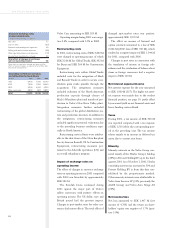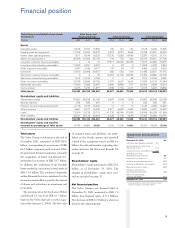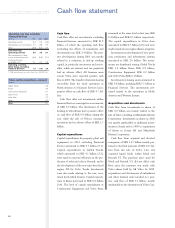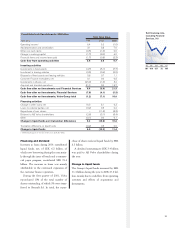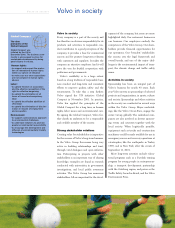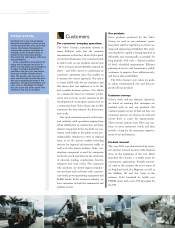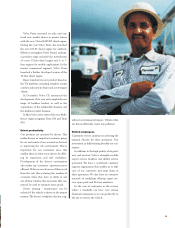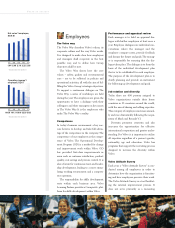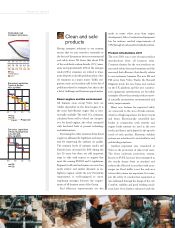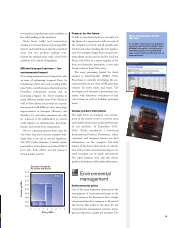Volvo 2001 Annual Report Download - page 32
Download and view the complete annual report
Please find page 32 of the 2001 Volvo annual report below. You can navigate through the pages in the report by either clicking on the pages listed below, or by using the keyword search tool below to find specific information within the annual report.
Clean and safe
products
Having transport solutions as our mission
means that we put ourselves constantly in
the focus of discussions about environmental
and safety issues. We know that about 25%
of the worldwide carbon dioxide (CO2) emis-
sions and approximately 20% of the nitrogen
oxides (NOx) emissions are related to trans-
ports. Reports on health problems show vehi-
cle emissions as a major source. Traffic con-
gestion, noise and accidents add to the list of
problems related to transport, but this is also
a list of challenges and business opportunities.
Diesel engines and the environment
All business areas except Volvo Aero are
wholly dependent on the diesel engine. It is
the most fuel-efficient engine that is com-
mercially available. The total CO2emissions,
calculated from well to wheel, are competi-
tive for diesel engines, also when compared
with bio-based fuels at present technology
and infrastructure.
Decreasing the other emissions from diesel
engines is addressed by legislation and impor-
tant for improving the ambient air quality.
The emission levels of nitrogen oxides and
Particles have decreased by 80% during the
last 20 years, but there are still important
steps to take with respect to engines that
meet the coming EURO4 and 5 regulations.
Engines for off-road and marine use now face
much stricter and similar demands as on-
highway engines, which the new Powertrain
organization is well-equipped to meet,
employing synergies between the require-
ments of all business areas of the Group.
Fuel efficiency improvements are also
made in many other areas than engine
development,Volvo Construction Equipment
has for instance reached improvements of
15% through a load-sensitive hydraulic system.
Product introductions 2001
The year 2001 was a year of major product
introductions from all business areas.
Common themes for the new products are
increased safety, decreased emissions and the
increased fuel efficiency that directly relates
to our customers’ business. The new FH and
FM series from Volvo Trucks, the Renault
Magnum truck, the new buses and coaches
on the TX platform and the new construc-
tion equipment introductions are favorable
examples of how the normal product renew-
al naturally incorporates environmental and
safety improvements.
Many new features for improved safety
are connected to the area of brake systems,
which is of high importance for heavy trucks
and buses. Electronically controlled disc
brakes in conjunction with retarder and
engine brake systems are used in the new
trucks and buses, and adapted to the specific
needs of each product. Electronic stability
systems are introduced to avoid rollover and
jack-knifing situations.
Another important area considered at
Volvo is the protection of other road users.
The front underrun protection system,
known as FUPS, has now been integrated in
the trucks chassis front as standard and
reduces the effects of an accident with a pas-
senger car. Road traffic is not the only area
where safety issues are important, for exam-
ple, the safety of construction equipment is
also addressed through the design of the cab.
Comfort, visibility and good working condi-
tions have been further enhanced with the
VOLVO IN SOCIETY
95 00 05 10 15 20
100 7 6 52322319
100 7 2 47271917
100 10 8 113 112 112 112
Estimated road
transport emissions
■ NOx
■ PM-diesel
■ CO2
95 00 05 10
EU
US
Japan
Emission Legislation
Trucks & Buses
NOx (g/kWh)
9
6
3
Proposed
95 00 05 10
EU
US
Emission Legislation
Offroad Applications
225–450 kW,
NOx (g/kWh)
12
8
4


